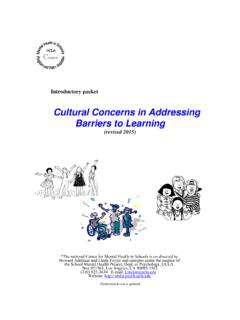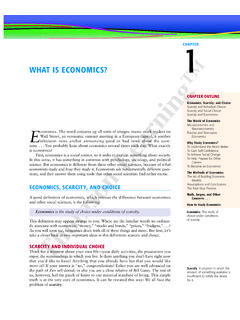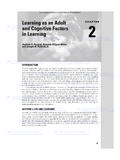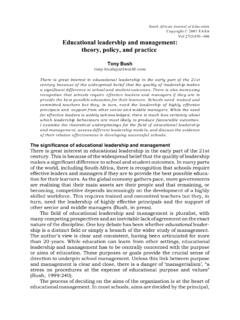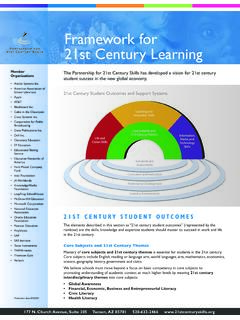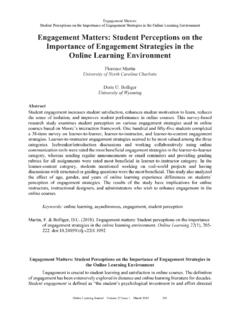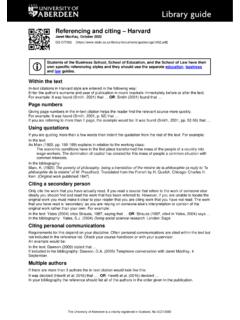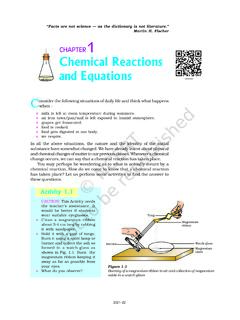Transcription of Assessment for Learning
1 VocationalLearning SupportProgramme:16 19 VocationalLearning SupportProgramme:16 19Dr Cheryl A Jonesassessment for learningTeachers make professional judgements on learners performance in every teaching and Learning session undertaken, whether consciously or subconsciously. Using these professional judgements and translating them into feedback on the quality of individuals work is the focus of the Assessment for Learning concentrating on the learner and the quality of Learning in individual classroom sessions, this publication supports practitioners striving for improved teacher-led for learningDr Cheryl A Jonesafl_txt_final 24/3/05 7:40 am Page iPublished by the Learning and Skills Development should be sent to :Vocational Learning Suppor t Programme : 16 19 Learning and Skills Development AgencyRegent Arcade House19 25 Argyll StreetLondon W1F 020 7297 9144 Fax 020 7297 with the Charity CommissionersAuthor : Dr Cheryl A JonesProject manager : Ian DuckettCopyedited and designed by thingswedoPrinter.
2 Newnor th LtdISBN 1 84572 064 4 CIMS 041723GR Learning and Skills Development Agency 2005 You are welcome to copy this publication for internal use within your organisation. Otherwise, no part of this publication may be reproduced, stored in a retrieval system, or transmitted in any form or by any means, electronic, electrical, chemical, optical, photocopying, recording or otherwise, without prior written permission of the copyright informationFor fur ther information about the issues discussed in this publicationplease contact :Ian DuckettLearning and Skills Development 020 7297 to Ann Stahler, Acting Headteacher, and Sue McDonough, ActingDeputy Headteacher, of New Heys Community School a Business andEnterprise College in south Liverpool, for their help and cooperation incompiling the case study incorporated within the text. Much appreciationalso goes to Valerie Peters for her advice and guidance during thecompilation of this 24/3/05 7:40 am Page iiContentsForewordIntroduction1 What is Assessment for Learning ?
3 4 Assessing Learning : the effective use of questioning10 Feedback for learning13 The New Heys model : a case study26 Assessment for Learning quality audit checklists37 Fur ther reading41afl_txt_final 24/3/05 7:40 am Page iiiForewordThis publication has been produced by the DfES-funded Vocational Learning Support Programme : 16 19 ( VLSP: 16 19 ) as part of its remit to support teachers and managers in delivering high-quality A-levels in vocational is more to Assessment than seeing if the requirements for achievinga qualification have been met. Formative Assessment is the assessmentused by teachers on an ongoing basis to help their students achieve to thebest of their abilities and is a very important part of the Learning process. In contrast, summative Assessment takes place on completion of a topic orunit and often contributes to the grading and Assessment of a for learningsupports practitioners and helps them focus onthe learner and Learning in individual classroom sessions.
4 It also shows how one of the Assessment for Learning strategy s principal themes, qualityfeedback, can be used to help learners progress. Many teachers haveexpressed concern in recent years that the introduction of burdensomeassessment requirements detracts from effective classroom practice andprevents them meeting learners needs. The purpose of this publication is to help teachers develop Assessment for Learning strategies to : pimprove classroom practicepcontribute to the personalised Learning agenda, where learners areempowered to take an active part in their own learningpdevelop the confidence of learners to undertake peer and author, Dr Cheryl A Jones, is an experienced and highly respectedinspector of education and training, accomplished researcher, conference speaker and consultant. She has a plethora of knowledge and experience of educational issues and, with a doctorate in themanagement of quality of education, is best placed to offer practicalguidance to support staff in meeting learners individual needs to promote Learning and ultimately achievement.
5 This practical guide details a case study featuring New Heys CommunitySchool a specialist Business and Enterprise College located in southLiverpool which introduced Assessment for Learning as a key priority in2004/05 to help the school meet its primary goal of continually improvingachievement rates. Cher yl and I hope that readers will find this publicationto be a valuable contribution to the Assessment for Learning agenda andthe post-16 vocational DuckettDevelopment AdviserVocational Learning Suppor t Programme : 16 19afl_txt_final 24/3/05 7:40 am Page iv1 IntroductionTeachers make professional judgements on learners performance in ever y teaching and Learning session under taken, whether consciously orsubconsciously. Using these professional judgements and translating them into feedback on the quality of individuals work is the focus ofAssessment for Learning . Successful Assessment for Learning strategiesresult in improved learner progress on a continual basis.
6 The principalcharacteristic of Assessment for Learning is effective feedback provided by teachers to learners on their progress. The value of the feedback isdependent on two factors :pthe quality of the feedbackphow learners receive and ultimately use , therefore, need training and support to enable them to makevaluable Assessment decisions, to provide quality feedback to learners,and to teach learners to receive feedback positively and use theinformation contained within it effectively to improve their for Learning and quality feedback can and do promoteincreased learner progress. However, Assessment oflearning rather thanassessment forlearning has preoccupied the minds of the profession for many years in an effort to meet awarding body of Learning can detract from effective classroom practice and prevent feeding back Assessment decisions to learners on theirperformance with the view to improving their work.
7 The Working Group on 14 19 Reform, led by Sir Mike Tomlinson, set out itsfinal recommendations in and his colleagues endorse therefocusing on teacher-led Assessment and, by introducing Assessment forLearning now, educational establishments are providing opportunities forteachers to develop their Assessment and feedback skills while promotingconfidence in their professional judgement and fostering an effectivelearning environment. By putting the learner at the heart of the assessmentprocess and refocusing the objective so that the learner becomes theprimary benefactor, improved meaning to teachers and value to learnerscan be Group on14 19 Reform ( 2004 ) .14 19 curriculum andqualifications 24/3/05 7:40 am Page 1We know from numerous Ofsted reports the power of Assessment forlearning. Indeed Ofsted tells us that just four schools out of 10 useassessment for Learning well, which clearly indicates that there is much todo to improve classroom practice.
8 Ofsted, the Working Group on 14 19 Reform, and the White Paper 14 19 education and skills2call forstrategies to fur ther engage and actively stretch all learners to reach theirfull potential : Assessment for Learning is a proven strategy that can anddoes help teachers to meet these important challenges, as is evident ininstitutions that are deploying these strategies to best his speech at the 2004 North of England Conference, David Miliband MP,former Minister of State for School Standards, highlighted the need forteachers to develop Assessment for Learning strategies in the quest to meetthe personalised Learning agenda. Without effective Assessment forlearning strategies, which involves high-quality feedback to learners beingembedded within ever y teaching and Learning session, the personalisedlearning agenda is a dream that will never be realised. Miliband described personalised Learning as :High expectations of every child, given practical form by high qualityteaching based on a sound knowledge and understanding of each child s needs.
9 It is not individualised Learning where pupils sit alone. Nor is it pupils left to their own devices which too often reinforces low aspirations. It means shaping teaching around the way differentyoungsters learn; it means taking the care to nur ture the unique talents of every following extract is lifted from A national conversation aboutpersonalised Learning :A personalised offer depends on really knowing the strengths andweaknesses of individual children and young people. We believe a keymeans of doing so is Assessment for Learning and the use of evidenceand dialogue to identify every pupil s Learning needs .. But whatever thecontextual practice, the rationale is always the same: clear evidenceabout how to drive up individual attainment; clear feedback for and frompupils so there is clarity on what they need to improve and how best theycan do so; and a clear link between Learning and lesson White Paper, 14 19 education and skills,5highlights the need toreduce the burden of external Assessment while challenging and stretchingthe more able learner.
10 Teachers will welcome this change in focus, which willallow them to free up time to get back to basics ; they need to undertakeinternal Assessment for the benefit of learners not purely to meet therequirement of external Assessment regimes and, as a result, maximiselearning and improve attainment in individual teaching and Learning sessions. 2 Assessment for learning2 DfES ( 2005 ) . 14 19education and forEducation and Choice and voice inpersonalised Learning .A speech by DavidMiliband MP, formerMinister of State forSchool Standards, atthe North of EnglandConference in DfES(2005). A nationalconversation aboutpersonalised Learning a summary of the DfESdiscussion forEducation and Skills, ( 2005 ) . Anational conversationabout personalisedlearning a summary of the DfES discussionpamphlet. Departmentfor Education and Skills, ( 2005 ) . 14 19education and forEducation and 24/3/05 7:40 am Page 2 Personalised Learning has five key components and Assessment forlearning is at the heart of its philosophy.











